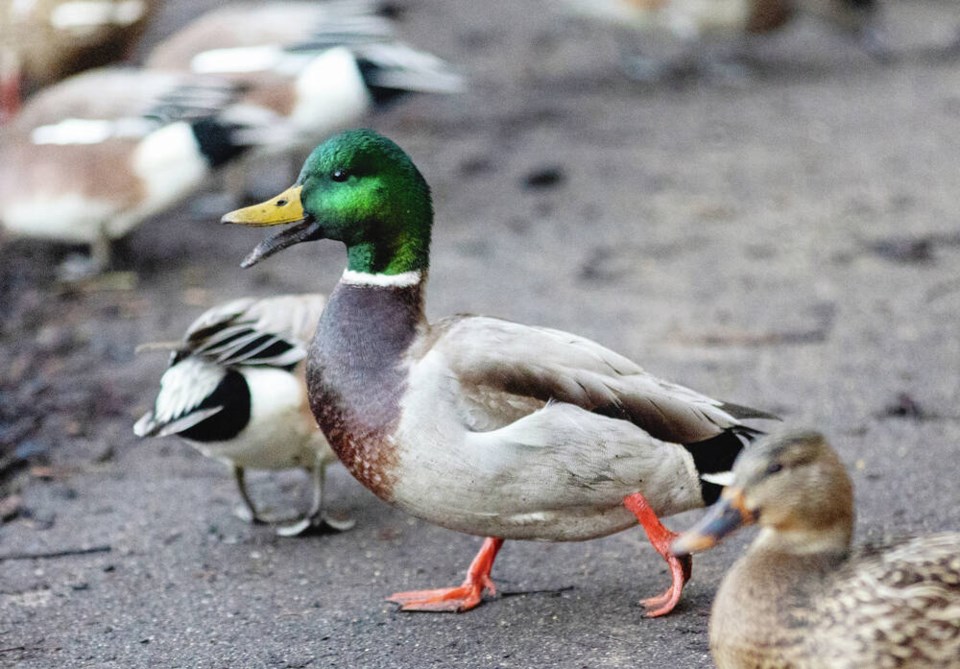While the highly contagious avian flu has wiped out millions of poultry birds across North America this year, populations of water fowl, raptors and even crows and ravens are also likely seeing untold losses, say wildlife rescue organizations.
“All of the birds we are seeing are in areas where humans find them, but there are much more we probably never see that die in remote areas,” said Derek Downs, a bird and wildlife rehabilitator at the North Island Wildlife Recovery Centre in Errington.
“We have definitely seen an uptick in sick birds this year — geese, ducks and swans.”
At the Mountain Avian Rescue Centre in the Comox Valley, bird rehabilitator Jyl Andersen said about 50 birds stricken with the deadly flu virus have been brought into the centre — some in the spring, but most during the fall migration.
That includes geese, swans, gulls and some eagles brought in from the Comox Valley and Campbell River areas and as far away as Salt Spring Island.
Most die within 24 hours or have to be euthanized.
“We’re seeing serious neurological symptoms not caused by trauma or poisons,” said Andersen. “They are un-co-ordinated, have cloudy eyes or discharges from their eyes and they are in a very weakened state.
“There’s not much we can do for them … it’s very sad because you can see they are suffering.”
The highly contagious H5N1 virus has been spreading rapidly from migratory birds to domestic flocks and wild scavengers such as crows and eagles.
The avian flu has wiped out an estimated 50.54 million birds in the United States this year, making it the country’s deadliest outbreak in history. The toll of chickens, turkeys and other birds tops the previous record of 50.5 million birds that died in an avian-flu outbreak in 2015.
In Canada, the poultry industry is also seeing unprecedented death tolls on domestic flocks, with the culling of 4.6 million turkeys, chickens and geese on 220 farms, including 1.2 million culled birds in B.C. and another 1.1 million in Alberta. Avian flu has hit every province except Prince Edward Island.
As of Monday, B.C. has 60 farms with ongoing cases of avian flu, the highest of any province. The virus was detected in six additional farms in the Fraser Valley over the past three days.
Avian flu is spread through contact with an infected bird or its feces or nasal or mouth secretions. Farm birds that go outside are most at risk because they can come in direct contact with infected wild birds or their feces.
Humans can also inadvertently carry the infection into a barn or a refuge centre on their shoes or clothing.
The Canadian Food Inspection Agency said no human cases have been detected in Canada and the illness is not considered a significant concern for healthy people who are not in regular contact with infected birds.
Both the wildlife rescue centres on the Island say they’ve had to change protocols at facilities to protect their resident birds recovering from injuries.
“It can be very challenging because we have to isolate the [avian flu] birds,” said Andersen.
The centres have also had to step up sanitizing and use of protective clothing and gloves, and ask visitors to wear shoe coverings.
Downes said it’s sometimes difficult to differentiate avian flu from lead poisoning and other contaminants, as some of the symptoms are the same.
He said the Island is coming off a record drought where low water levels have opened new ground to forage in estuaries and lakes. Feces mixed with food sources, lead from shotgun shells and fishing weights, and other contamination can be ingested by waterfowl and raptors.
Downes said the number of sick swans and geese being brought to the Errington centre has increased, including birds that stay over the winter.
“We see certain pathogens every year, but this [strain] seems to be more prevalent especially in the water fowl,” he said. “You look at the amazing migration undertaken by these birds, the vast distances and the intermingling of individual birds … they have a robust immune systems that domestic flocks just don’t have.”
The rescue centres are bagging the birds and sending them to a provincial wildlife lab in Abbotsford.
The Canadian Food Inspection Agency reported 1,484 confirmed cases of avian flu in wild birds across Canada as of Monday, including 144 in B.C. Quebec has so far had the most cases at 255, followed by Saskatchewan, Alberta and B.C.
Theresa Burns, B.C.’s chief veterinarian, said the numbers are likely much higher because it is impossible to determine how many wild animals have died.
“For [avian flu] to be detected in a wild bird, first you have to find the carcass, then the carcass has to get submitted to the lab, then it has to be tested. So, we imagine that there’s many birds that might be dying that we’re not able to detect.”
Ann Nightingale of Victoria’s Rocky Point Bird Observatory said songbirds such as sparrows and robins have not been affected by the avian flu strain, but birds that scavenge such as crows, ravens and vultures as well as gulls and shore birds are a concern.
Anyone who finds a sick or dead wild bird is advised to call the B.C. Wild Bird Mortality Reporting Line (1-866-431-2473), which is jointly managed by the Canadian Wildlife Service and B.C. Wildlife Health Program.
They advise not handling potentially sick birds, and said calls will be answered on a priority basis as resources allow.
— With files from The Canadian Press
>>> To comment on this article, write a letter to the editor: [email protected]



